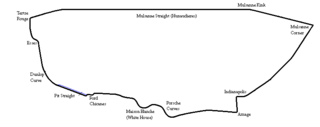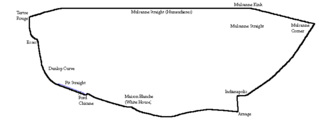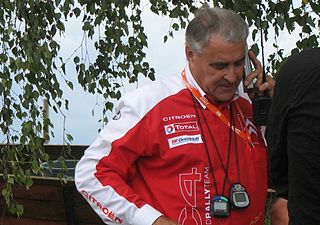
The Porsche 935 was a race car developed and manufactured by German automaker Porsche. Introduced in 1976 as the factory racing version of the 911 (930) Turbo and prepared for FIA-Group 5 rules, it was an evolution of the Carrera RSR 2.1 turbo prototype, the second place overall finisher in the 1974 24 Hours of Le Mans.

Jean-Pierre Alain Jabouille is a French former racing driver. He raced in 55 Formula One Grands Prix, collecting two wins during the first years of Renault's turbocharged programme in the late 1970s and early 1980s. Jabouille also raced the 24 Hours of Le Mans from the late 1960s to the early 1990s, driving for Alpine, Matra, Sauber and Peugeot and collecting four 3rd overall finishes in 1973, 1974, 1992 and 1993. Jabouille was one of the last of a breed of Formula One drivers who were also engineers.

Rolf Johann Stommelen was a racing driver from Siegen, Germany. He participated in 63 Formula One World Championship Grands Prix, achieving one podium, and scored a total of 14 championship points. He also participated in several non-Championship Formula One races.

The 1982 24 Hours of Le Mans was the 50th Grand Prix of Endurance, which took place on 19 and 20 June 1982. It was also the fourth round of the 1982 World Endurance Championship. As well as a significant anniversary, this was a watershed year for Le Mans, with the highly anticipated advent of the FIA's Group C regulations, the essence of which was to allow an open engine formula but a minimum weight for safety and a proscribed fuel allocation.

The 1981 24 Hours of Le Mans was the 49th Grand Prix of Endurance, and took place on 13 and 14 June 1981. It was also the eighth round of the World Endurance Championship of Drivers, and the fifth round of the World Championship for Makes.

The 1980 24 Hours of Le Mans was the 48th Grand Prix of Endurance, and took place on 14 and 15 June 1980. It was the seventh round of both the World Championship for Makes and World Challenge for Endurance Drivers. With neither the Porsche nor Renault works teams contesting the big Group 6 sports-cars for outright victory, it left the prospects open for a privateer victory from Joest, Rondeau or De Cadenet, or from Group 5 again, if they were to fail. The wet weather throughout the race further added to the uncertainty, reducing the advantage of the more powerful cars.

The 1979 24 Hours of Le Mans was the 47th Grand Prix of Endurance, and took place on 9 and 10 June 1979. With no other major works cars this year, the Porsche team were the strong favourites to win. Their competition would be from Cosworth-powered Mirages and Rondeaus and a swarm of Group 5 and IMSA-class Porsche 935s. The other big talking point was the presence of Hollywood actor Paul Newman, driving for Dick Barbour Racing.

The 1978 24 Hours of Le Mans was the 46th Grand Prix of Endurance, and took place on 10 and 11 June 1978. In many ways it was a continuation of the race from the year before – the two main protagonists would be the very evenly-matched works teams of Alpine-Renault and Porsche, with four cars each. The race was not valid for any championship.

The 1977 24 Hours of Le Mans was the 45th Grand Prix of Endurance, and took place on 11 and 12 June 1977. The second year of the FIA Group 5 and Group 6 regulations, it produced an exciting race right up to the end. Porsche had withdrawn from the Group 6 Championship, citing a lack of broad competition. Renault, before their move into Formula 1, decided to put its main racing focus for the year onto Le Mans. The two works teams were the pre-race favourites.

The 1976 24 Hours of Le Mans was the 44th Grand Prix of Endurance, and took place on 12 and 13 June 1976. This year the FIA introduced its new Group 5 and Group 6 regulations and the race was now open to nine distinct classes, although it was still not part of the World Championship seasons. Porsche introduced its new models, the 936 in Group 6, the 935 in Group 5 and the 934 in Group 4. In response, BMW had its modified 3.0 CSL in Group 5. It was the year that turbos arrived in considerable numbers, with over a dozen turbocharged entries, led by the Renault Alpine A442. It saw the arrival of French prototype manufacturers Jean Rondeau and Gérard Welter in a new GTP class and a first-time invitation to American IMSA and NASCAR entries.

The 1975 24 Hours of Le Mans was the 43rd Grand Prix of Endurance, and took place on 14 and 15 June 1975. Colloquially called the “Le Mans Economy Run”, stringent refuelling regulations were put in place. Unable to match the requisite 7mpg fuel economy the manufacturer teams from Ferrari, Alfa Romeo withdrew and Matra had retired from the sport at the end of 1974. Therefore, this only left Gulf and Ligier as front-running works-teams.

The 1974 24 Hours of Le Mans was the 42nd Grand Prix of Endurance, and took place on 15 and 16 June 1974. It was the fifth round of the 1974 World Championship for Makes. After Alfa Romeo had won the first race of the season at Monza, it had been Matra all the way and they came to Le Mans as firm favourites for a third consecutive outright victory, especially after Alfa Romeo withdrew its cars just before raceweek.

The 1973 24 Hours of Le Mans was the 41st Grand Prix of Endurance and took place on 9 and 10 June 1973. It was the eighth round of the 1973 World Championship of Makes.

The 1972 24 Hours of Le Mans was the 40th Grand Prix of Endurance, and took place on 10 and 11 June 1972. It was the ninth round of the 1972 World Championship for Makes.

The 1969 24 Hours of Le Mans was the 37th Grand Prix of Endurance, and took place on 14 and 15 June 1969. It was the eighth round of the 1969 World Sportscar Championship season.

The 1968 24 Hours of Le Mans was the 36th Grand Prix of Endurance, and took place on 28 and 29 September 1968 on the Circuit de la Sarthe, in Le Mans, France.

The 1967 24 Hours of Le Mans was the 35th Grand Prix of Endurance, and took place on 10 and 11 June 1967. It was also the seventh round of the 1967 World Sportscar Championship.

Guy Fréquelin is a French former rally and sports car driver.

The Mulsanne Straight is the name used in English for a formerly 6 km (3.7 mi) long straight of the Circuit de la Sarthe around which the 24 Hours of Le Mans auto race takes place. Since 1990, the straight is interrupted by two chicanes, with the last section leading to a sharp corner near the village of Mulsanne.
The CH-Type was a 90° V6 engine developed by Renault-Gordini for Renault's autosport activities. This François Castaing design was the predecessor of the famous EF series.

















